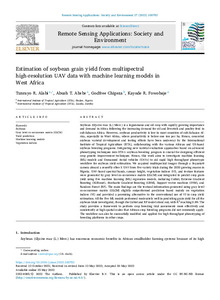| dc.contributor.author | Alabi, T.R. |
| dc.contributor.author | Abebe, A.T. |
| dc.contributor.author | Chigeza, G. |
| dc.contributor.author | Fowobaje, K.R. |
| dc.date.accessioned | 2022-06-07T08:54:01Z |
| dc.date.available | 2022-06-07T08:54:01Z |
| dc.date.issued | 2022-08 |
| dc.identifier.citation | Alabi, T.R., Abebe, A.T., Chigeza, G. & Fowobaje, K.R. (2022). Estimation of soybean grain yield from multispectral high-resolution UAV data with machine learning models in west Africa. Remote Sensing Applications: Society and Environment, 27: 100782, 1-17. |
| dc.identifier.issn | 2352-9385 |
| dc.identifier.uri | https://hdl.handle.net/20.500.12478/7489 |
| dc.description.abstract | Soybean (Glycine max (L.) Merr.) is a leguminous and oil crop with rapidly growing importance and demand in Africa following the increasing demand for oil and livestock and poultry feed in sub-Saharan Africa. However, soybean productivity is low in most countries of sub-Saharan Africa, especially in West Africa, where productivity is below one ton per ha. Hence, concerted soybean varietal development and testing efforts have been underway by the International Institute of Tropical Agriculture (IITA), collaborating with the various African and US-based soybean breeding programs. Integrating new varietal evaluation approaches based on advanced phenotyping techniques into IITA's soybean breeding program is crucial for designing efficient crop genetic improvement techniques. Hence, this work aims to investigate machine learning (ML) models and Unmanned Aerial vehicles (UAVs) to aid rapid high throughput phenotypic workflow for soybean yield estimation. We acquired multispectral images through a Sequoia® camera aboard a senseFly eBee X UAV from five variety trials during the 2020 growing season in Nigeria. UAV-based spectral bands, canopy height, vegetation indices (VI), and texture features were generated by gray level co-occurrence matrix (GLCM) and integrated to predict crop grain yield using five machine learning (ML) regression models, including Cubist, Extreme Gradient Boosting (XGBoost), Stochastic Gradient Boosting (GBM), Support vector machine (SVM), and Random Forest (RF). The main findings are the textural information generated using gray level co-occurrence matrix (GLCM) slightly outperformed predictors based mainly on vegetation indices (VI) and provided a promising alternative to the conventional use of VI in crop yield estimation. All the five ML models performed moderately well in predicting grain yield for all the soybean trials investigated, though the Cubist and RF model stood out, with R2 reaching 0.89. The study provides a framework to perform crop breeding trial assessments more effectively and consistently at high spatial scales that African crop breeding programs did not commonly apply. The workflow can also be successfully modified and applied for high throughput phenotyping of breeding platforms in other crops. |
| dc.description.sponsorship | United States Agency for International Development |
| dc.format.extent | 1-10 |
| dc.language.iso | en |
| dc.subject | Soybeans |
| dc.subject | Yields |
| dc.subject | Forecasting |
| dc.subject | Machine Learning |
| dc.title | Estimation of soybean grain yield from multispectral high-resolution UAV data with machine learning models in west Africa |
| dc.type | Journal Article |
| cg.contributor.affiliation | International Institute of Tropical Agriculture |
| cg.coverage.region | Africa |
| cg.coverage.region | West Africa |
| cg.coverage.country | Nigeria |
| cg.coverage.hub | Southern Africa Hub |
| cg.coverage.hub | Headquarters and Western Africa Hub |
| cg.researchtheme | Biotech and Plant Breeding |
| cg.identifier.bibtexciteid | ALABI:2022 |
| cg.isijournal | ISI Journal |
| cg.authorship.types | CGIAR Single Centre |
| cg.iitasubject | Agronomy |
| cg.iitasubject | Food Security |
| cg.iitasubject | Grain Legumes |
| cg.iitasubject | Plant Breeding |
| cg.iitasubject | Plant Production |
| cg.iitasubject | Soybean |
| cg.journal | Remote Sensing Applications: Society and Environment |
| cg.notes | Open Access Article; Published online: 25 May 2022 |
| cg.accessibilitystatus | Open Access |
| cg.reviewstatus | Peer Review |
| cg.usagerightslicense | Creative Commons Attribution 4.0 (CC BY 0.0) |
| cg.targetaudience | Scientists |
| cg.identifier.doi | https://dx.doi.org/doi:10.1016/j.rsase.2022.100782 |
| cg.iitaauthor.identifier | Tesfaye Getachew Mengistu: 0000-0002-0544-6314 |
| cg.iitaauthor.identifier | Godfree Chigeza: 0000-0002-9235-0694 |
| cg.futureupdate.required | No |
| cg.identifier.issue | : 100782 |
| cg.identifier.volume | 27 |
| cg.contributor.acknowledgements | We would like to acknowledge the Soybean Innovation Lab for facilitating and financially supporting the Pan African Variety Trial (PAVT) in Nigeria. We want to acknowledge the different National Soybean Breeding Programs that contributed to the soybean varieties used in the Pan-African Variety Trial. |

